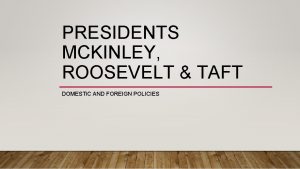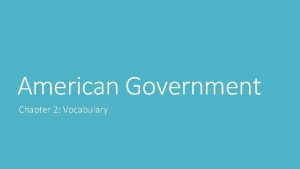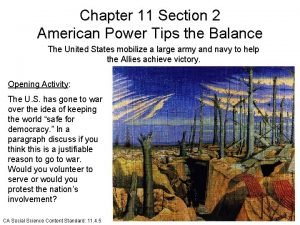AMERICAN GOVERNMENT Chapter 16 DOMESTIC POLICY Power Point























- Slides: 23

AMERICAN GOVERNMENT Chapter 16 DOMESTIC POLICY Power. Point Image Slideshow

FIGURE 16. 1 Minnesota Tea Party members protest in 2011, demanding repeal of the recently enacted Patient Protection and Affordable Care Act. Protests against expanding the federal government’s role in the economy often use “socialism” as a negative label, even when defending existing examples of government-run programs such as Medicare. (credit: modification of work by “Fibonacci Blue”/Flickr) This Open. Stax ancillary resource is © Rice University under a CC-BY 4. 0 International license; it may be reproduced or modified but must be attributed to Open. Stax, Rice University and any changes must be noted. Any images credited to other sources are similarly available for reproduction, but must be attributed to their sources.

FIGURE 16. 2 President Obama signs a 2009 executive order to accelerate the federal government’s recruitment and hiring of returning veterans. Executive orders are an expression of public policy undertaken at the discretion of the president. This Open. Stax ancillary resource is © Rice University under a CC-BY 4. 0 International license; it may be reproduced or modified but must be attributed to Open. Stax, Rice University and any changes must be noted. Any images credited to other sources are similarly available for reproduction, but must be attributed to their sources.

FIGURE 16. 3 In 1937, during the Great Depression, families in Calipatria, California, waited in line for relief checks, part of the federal government’s newly introduced social safety net. (credit: modification of work by the Library of Congress) This Open. Stax ancillary resource is © Rice University under a CC-BY 4. 0 International license; it may be reproduced or modified but must be attributed to Open. Stax, Rice University and any changes must be noted. Any images credited to other sources are similarly available for reproduction, but must be attributed to their sources.

FIGURE 16. 4 This Library of Congress photo shows an early nineteenth-century subsistence farm in West Virginia, which once included crops, livestock, and an orchard. (credit: modification of work by the Library of Congress) This Open. Stax ancillary resource is © Rice University under a CC-BY 4. 0 International license; it may be reproduced or modified but must be attributed to Open. Stax, Rice University and any changes must be noted. Any images credited to other sources are similarly available for reproduction, but must be attributed to their sources.

FIGURE 16. 5 Air pollution billows from a power plant before the installation of emission control equipment for the removal of sulfur dioxide and particulate matter. Can you see why uncontrolled pollution is an example of the “tragedy of the commons”? This Open. Stax ancillary resource is © Rice University under a CC-BY 4. 0 International license; it may be reproduced or modified but must be attributed to Open. Stax, Rice University and any changes must be noted. Any images credited to other sources are similarly available for reproduction, but must be attributed to their sources.

FIGURE 16. 6 In an example of distributive policy, the Union Pacific Railroad was given land resources to help build a national railroad system. Here, its workers construct the Devil’s Gate Bridge in Utah in 1869. This Open. Stax ancillary resource is © Rice University under a CC-BY 4. 0 International license; it may be reproduced or modified but must be attributed to Open. Stax, Rice University and any changes must be noted. Any images credited to other sources are similarly available for reproduction, but must be attributed to their sources.

FIGURE 16. 7 Workers construct the Hoover Dam, a distributive policy project, in Nevada in 1932. This Open. Stax ancillary resource is © Rice University under a CC-BY 4. 0 International license; it may be reproduced or modified but must be attributed to Open. Stax, Rice University and any changes must be noted. Any images credited to other sources are similarly available for reproduction, but must be attributed to their sources.

FIGURE 16. 8 In 1930, when this Ford automotive plant opened in Long Beach, California, American workers had few economic protections to rely on if they were injured or could not maintain such physical activity as they aged. This Open. Stax ancillary resource is © Rice University under a CC-BY 4. 0 International license; it may be reproduced or modified but must be attributed to Open. Stax, Rice University and any changes must be noted. Any images credited to other sources are similarly available for reproduction, but must be attributed to their sources.

FIGURE 16. 9 President George W. Bush discusses Social Security in Florida at the outset of his second term in 2005. This Open. Stax ancillary resource is © Rice University under a CC-BY 4. 0 International license; it may be reproduced or modified but must be attributed to Open. Stax, Rice University and any changes must be noted. Any images credited to other sources are similarly available for reproduction, but must be attributed to their sources.

FIGURE 16. 10 NASA launches the space shuttle Discovery from the Kennedy Space Center in 2007. Should the private sector fund space exploration programs rather than the government? (credit: NASA) This Open. Stax ancillary resource is © Rice University under a CC-BY 4. 0 International license; it may be reproduced or modified but must be attributed to Open. Stax, Rice University and any changes must be noted. Any images credited to other sources are similarly available for reproduction, but must be attributed to their sources.

FIGURE 16. 11 In 2010, members of PETA (People for the Ethical Treatment of Animals) demonstrate against a local zoo. As policy advocates, PETA’s members often publicize their position on how animals should be treated. This Open. Stax ancillary resource is © Rice University under a CC-BY 4. 0 International license; it may be reproduced or modified but must be attributed to Open. Stax, Rice University and any changes must be noted. Any images credited to other sources are similarly available for reproduction, but must be attributed to their sources.

FIGURE 16. 12 First Lady Michelle Obama shows her AARP membership card on her fiftieth birthday in January 2014. AARP is a major policy advocate for older people and retirees. This Open. Stax ancillary resource is © Rice University under a CC-BY 4. 0 International license; it may be reproduced or modified but must be attributed to Open. Stax, Rice University and any changes must be noted. Any images credited to other sources are similarly available for reproduction, but must be attributed to their sources.

FIGURE 16. 13 The Congressional Budget Office (CBO) is responsible for studying the impact of all proposed legislation to assess its net effect on the budget and tracking federal debt. For example, this 2010 CBO chart shows federal debt held by the public as a percentage of gross domestic product from 1790 through 2010 and projected to 2035. This Open. Stax ancillary resource is © Rice University under a CC-BY 4. 0 International license; it may be reproduced or modified but must be attributed to Open. Stax, Rice University and any changes must be noted. Any images credited to other sources are similarly available for reproduction, but must be attributed to their sources.

FIGURE 16. 14 The White House petition website encourages citizens to participate in the democratic process. This Open. Stax ancillary resource is © Rice University under a CC-BY 4. 0 International license; it may be reproduced or modified but must be attributed to Open. Stax, Rice University and any changes must be noted. Any images credited to other sources are similarly available for reproduction, but must be attributed to their sources.

FIGURE 16. 15 Strategists discuss the budget in the Roosevelt Room of the White House in 2009. This Open. Stax ancillary resource is © Rice University under a CC-BY 4. 0 International license; it may be reproduced or modified but must be attributed to Open. Stax, Rice University and any changes must be noted. Any images credited to other sources are similarly available for reproduction, but must be attributed to their sources.

FIGURE 16. 16 This chart of U. S. federal spending for 2015 shows the proportions of mandatory and discretionary spending, about 57 percent and 43 percent, respectively. This Open. Stax ancillary resource is © Rice University under a CC-BY 4. 0 International license; it may be reproduced or modified but must be attributed to Open. Stax, Rice University and any changes must be noted. Any images credited to other sources are similarly available for reproduction, but must be attributed to their sources.

FIGURE 16. 17 The war in Afghanistan, ongoing since 2001, has cost the United States billions of dollars in discretionary military spending authorized by Congress every year. This Open. Stax ancillary resource is © Rice University under a CC-BY 4. 0 International license; it may be reproduced or modified but must be attributed to Open. Stax, Rice University and any changes must be noted. Any images credited to other sources are similarly available for reproduction, but must be attributed to their sources.

FIGURE 16. 18 A U. S. marine fills out an income tax form. Income taxes in the United States are progressive taxes. This Open. Stax ancillary resource is © Rice University under a CC-BY 4. 0 International license; it may be reproduced or modified but must be attributed to Open. Stax, Rice University and any changes must be noted. Any images credited to other sources are similarly available for reproduction, but must be attributed to their sources.

FIGURE 16. 19 A gas station shows fuel prices over $3. 00 a gallon in 2005, shortly after Hurricane Katrina disrupted gas production in the Gulf of Mexico. Taxes on gasoline that are based on the quantity purchased are regressive taxes. This Open. Stax ancillary resource is © Rice University under a CC-BY 4. 0 International license; it may be reproduced or modified but must be attributed to Open. Stax, Rice University and any changes must be noted. Any images credited to other sources are similarly available for reproduction, but must be attributed to their sources.

FIGURE 16. 20 This Open. Stax ancillary resource is © Rice University under a CC-BY 4. 0 International license; it may be reproduced or modified but must be attributed to Open. Stax, Rice University and any changes must be noted. Any images credited to other sources are similarly available for reproduction, but must be attributed to their sources.

FIGURE 16. 21 Investors crowd Wall Street during the Bankers Panic of 1907. This Open. Stax ancillary resource is © Rice University under a CC-BY 4. 0 International license; it may be reproduced or modified but must be attributed to Open. Stax, Rice University and any changes must be noted. Any images credited to other sources are similarly available for reproduction, but must be attributed to their sources.

FIGURE 16. 22 Economist Alan Greenspan (a) was chair of the board of governors of the Federal Reserve System from 1987 to 2006, the second-longest tenure of any chair. Current Fed chair Janet Yellen (b) succeeded Ben Bernanke in 2014, after serving as vice chair four years. Prior to serving on the Federal Reserve Board, Yellen was president and CEO of the Federal Reserve Bank of San Francisco. This Open. Stax ancillary resource is © Rice University under a CC-BY 4. 0 International license; it may be reproduced or modified but must be attributed to Open. Stax, Rice University and any changes must be noted. Any images credited to other sources are similarly available for reproduction, but must be attributed to their sources.
 William h taft domestic policy
William h taft domestic policy Hitler's domestic policy essay
Hitler's domestic policy essay Eisenhower domestic policies
Eisenhower domestic policies Domestic policies of napoleon
Domestic policies of napoleon Domestic policy
Domestic policy 12th amendment
12th amendment Hatshepsut family tree
Hatshepsut family tree Domestic policies of kennedy
Domestic policies of kennedy Domestic policy
Domestic policy George washingtons domestic policy
George washingtons domestic policy Chapter 2 american government
Chapter 2 american government Origins of american government vocabulary
Origins of american government vocabulary Chapter 2 origins of american government answer key
Chapter 2 origins of american government answer key Chapter 2 origins of american government worksheet answers
Chapter 2 origins of american government worksheet answers Chapter 2 lesson 1 government in colonial america
Chapter 2 lesson 1 government in colonial america Chapter 2 origins of american government
Chapter 2 origins of american government Chapter 4 federalism answer key
Chapter 4 federalism answer key Power triangle diagram
Power triangle diagram Power bi training powerpoint
Power bi training powerpoint Point point power
Point point power Chapter 11 section 2 american power tips the balance
Chapter 11 section 2 american power tips the balance The americans chapter 19
The americans chapter 19 Office of government wide policy
Office of government wide policy Andrew youngson
Andrew youngson












































